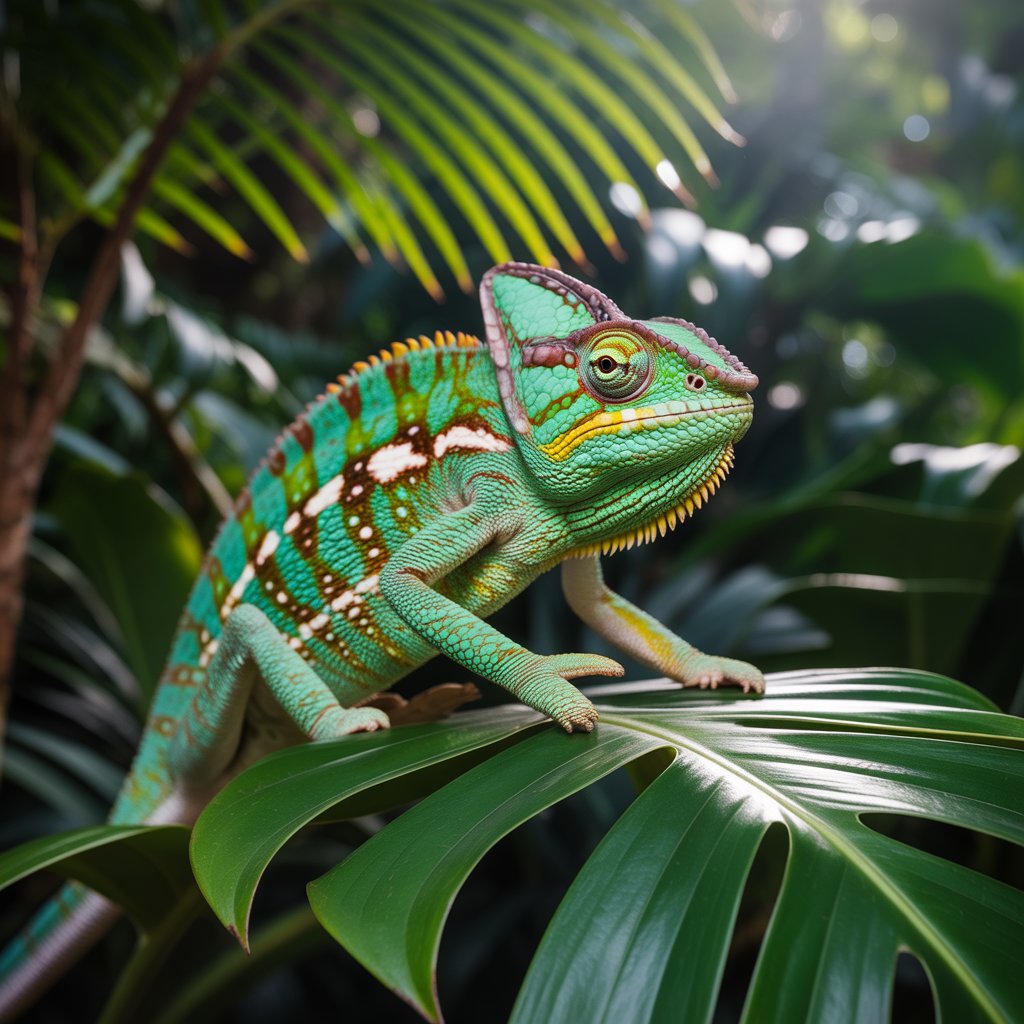Within the magnificent and diverse class of reptiles, few groups capture the human imagination quite like the family known scientifically as Chamaeleonidae, or in Czech and Slovak, Chameleónovité. These creatures are often mistakenly reduced to a single, albeit spectacular, party trick: their ability to change color. However, to define them solely by this attribute is to overlook the profound depth of their evolutionary design, which represents one of nature’s most extraordinary and specialized adaptations for survival. Chameleons are a masterclass in biological engineering, a family of lizards that have perfected the arts of hunting, navigation, and environmental interaction through a suite of features found nowhere else in the animal kingdom. From their independently mobile, stereoscopic eyes that grant a 360-degree view of the world to their lightning-fast, ballistic tongues that can snatch prey in milliseconds, every aspect of their anatomy tells a story of evolutionary refinement. This comprehensive guide delves beyond the myth and mystery to explore the true biology, behavior, and breathtaking diversity of the Chameleónovité family, offering a detailed examination of their unique physiology, their habitats across the Old World, the intricacies of their social communication, and the critical conservation challenges they face in a rapidly changing world.
The Evolutionary Marvel: Deconstructing the Anatomy of a Chameleon
The remarkable survival strategy of the Chameleónovité family is written in their very anatomy, a collection of highly specialized traits that have been perfected over millions of years. The most iconic of these is, undoubtedly, their capacity for metachrosis, or color change. Contrary to popular belief, this ability is not primarily used for camouflage against a patterned background. Instead, it is a complex form of communication, regulated by hormones, the nervous system, and specialized cells in their skin called chromatophores. These cells contain pigments and nanocrystals that reflect light, allowing chameleons to shift their appearance to regulate body temperature, signal aggression or submission to rivals, and communicate receptivity for mating. Equally fascinating is their visual system. Their eyes are conical structures covered by a fused eyelid with only a pinhole opening for the pupil. Each eye can rotate and focus independently, granting them a complete panoramic view to spot predators and prey without moving their head. When they locate an insect, they can switch to stereoscopic vision, combining the input from both eyes to gain precise depth perception—a critical ability for the next stage of their hunt. This hunt is concluded with their projectile tongue, a biomechanical marvel that can be extended to twice the length of their body at accelerations faster than a fighter jet. The tongue tip is a muscular, sticky pad that ensnares the prey and retracts it into the mouth in a fraction of a second, a movement too fast for the human eye to perceive in real time.
Global Distribution and Ecological Niches of the Chameleon Family
The Chameleónovité family is an Old World group, with its natural distribution overwhelmingly concentrated on the African continent, particularly on the island of Madagascar, which serves as a spectacular evolutionary hotspot and sanctuary for a vast majority of the world’s chameleon species. Madagascar is home to a stunning array of genera, from the tiny leaf chameleons (Brookesia), which are among the smallest reptiles on Earth and inhabit the leaf litter of the forest floor, to the large, charismatic panther chameleon (Furcifer pardalis), renowned for its vibrant and geographically varied coloration. Beyond Madagascar, chameleons are found throughout sub-Saharan Africa. A smaller number of species have a range that extends into southern Europe, specifically in coastal areas of Spain, Portugal, and Greece, and across parts of the Middle East and southern India. Each species has evolved to occupy a very specific ecological niche. Some are arboreal specialists, their zygodactylous feet (toes fused into opposed bundles of two and three) acting like perfect clamps to grip the smallest of branches. Others are terrestrial, having adapted to life in dry deserts or dense, humid forests. This specialization makes them exceptionally vulnerable to habitat destruction, as they are often unable to adapt to rapid changes in their environment.
Beyond Color: The Complex Behaviors and Social Structures
The life of a chameleon is one of solitude and sophisticated signaling. They are largely territorial and solitary animals, with complex social behaviors communicated through a visual lexicon of color changes, body posturing, and specific movements. A male approaching another male will often flush dark, contrasting colors, inflate his body to appear larger, and engage in a slow, rocking gait—a clear display of aggression and dominance intended to avoid a physically damaging fight. A female, if unreceptive to a male’s advances, will display aggressive coloration of her own, often dark with bright spots, and may hiss or attempt to bite. If receptive, her colors will remain neutral or subdued. Their reproductive strategies are equally diverse; while most species are oviparous, laying clutches of eggs in burrows dug in the soil, some, particularly those living in colder mountainous regions, are ovoviviparous. This means the eggs are retained inside the female’s body until they are ready to hatch, and she gives birth to live young, a adaptation that protects the developing embryos from unfavorable external temperatures.
Conclusion
The Chameleónovité family stands as a powerful testament to the creativity and precision of evolutionary forces. They are not simply lizards that change color; they are intricate, highly-evolved organisms whose every feature—from their panoramic vision and ballistic tongues to their specialized feet and complex communicative displays—serves a precise purpose in their survival. They remind us that nature’s most incredible wonders are often found in the details, in the slow and meticulous refinement of form and function over eons. However, this very specialization that makes them so fascinating also renders them profoundly vulnerable. Habitat loss, the exotic pet trade, and climate change pose significant threats to many species, particularly those with highly restricted ranges. Understanding and appreciating the true biology of chameleons, beyond the myths, is the first and most crucial step toward ensuring that these masters of adaptation can continue to thrive in their natural habitats, captivating and inspiring generations to come.
FAQ Section
Q1: What does “Chameleónovité” mean?
A: “Chameleónovité” is the Czech and Slovak word for the biological family Chamaeleonidae. It is the taxonomic term that encompasses all species of chameleons, just as “Felidae” encompasses all cats. Using this term refers to the entire scientific grouping rather than just the general concept of a chameleon.
Q2: How do chameleons change color, and is it really for camouflage?
A: Chameleons change color through specialized cells in their skin called chromatophores. These cells contain pigments (xanthophores for yellow/red, melanophores for brown/black) and guanine nanocrystals (iridophores) that reflect light. By expanding or contracting these cells, they change the wavelength of light reflected, thus changing color. While they can use this for limited background blending, its primary purposes are thermoregulation (turning dark to absorb heat, light to reflect it) and communication (signaling stress, aggression, or readiness to mate to other chameleons).
Q3: Where in the world can you find wild chameleons?
A: Chameleons are an “Old World” family. Their natural distribution is overwhelmingly concentrated in Africa, with the highest diversity found on the island of Madagascar, which is a biodiversity hotspot for them. Smaller populations exist in southern Europe (Spain, Greece), the Middle East, and parts of southern Asia, like India and Sri Lanka. They are not native to the Americas.
Q4: What is the difference between a veiled chameleon and a panther chameleon?
A: Both are popular in the pet trade but are distinct species.
-
Veiled Chameleon (Chamaeleo calyptratus): Native to Yemen and Saudi Arabia. They are known for the large, helmet-like casque on their head (larger in males) and are generally hardy. Their color palette often includes greens, yellows, and blues, with bold stripes.
-
Panther Chameleon (Furcifer pardalis): Native to Madagascar. They are famed for their incredibly vibrant and geographically varied coloration. Males from different regions exhibit specific color patterns (e.g., Ambanja are blue and green, Nosy Be are blue, Sambava are red and green). They lack the large casque of the veiled chameleon.
Q5: Are chameleons good pets?
A: Chameleons are considered advanced pets and are not recommended for beginner reptile keepers. They have very specific and demanding care requirements, including:
-
Specialized Enclosures: Well-ventilated screen cages of appropriate size.
-
Precise Environment: Specific temperature gradients and very high humidity levels that must be meticulously maintained.
-
Lighting: Requires specialized UVB lighting for calcium metabolism.
-
Diet and Hydration: A variety of live insects and often require specialized dripping or misting systems for hydration, as they rarely drink from a standing water bowl.
-
Temperament: They are easily stressed by handling and are best considered as “look, don’t touch” pets.
Prospective owners must undertake extensive research to provide a suitable and healthy environment.





